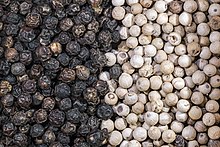Pepper plants
| Pepper plants | ||||||||||||
|---|---|---|---|---|---|---|---|---|---|---|---|---|

Foliage leaves and inflorescences of Piper auritum |
||||||||||||
| Systematics | ||||||||||||
|
||||||||||||
| Scientific name | ||||||||||||
| Piperaceae | ||||||||||||
| Giseke |
The pepper family (Piperaceae) are a family of plants from the order of the pepper-like (Piperales). The 13 genera with around 3600 species are distributed almost worldwide in the subtropics to the tropics . The most important genus from this family for humans is the pepper ( piper ).
description

They are woody plants: small trees and upright, twisting or twisting shrubs ( lianas ) or annual to perennial herbaceous plants . Rhizomes are often formed. Some species have an aromatic smell. Plant parts can be hairy to hairless or covered with glands. They grow terrestrially or epiphytically; some species are succulent . The mostly alternate and spiral or less often opposite or whorled, mostly stalked leaves are simple and herbaceous or fleshy. The leaf margin is smooth. Stipules are usually present and are often fused with the petioles.
The flowers are arranged in terminal, piston-shaped, spike-like inflorescences ; often it is Doldige in Zippelia traubige inflorescences. Each flower almost always stands over a small bract without a flower stalk. The small flowers are hermaphroditic or unisexual in Piper ; if they are unisex then the species are usually dioeciously segregated ( diocesan ). The flowers have no bracts . There are one to ten mostly free stamens . Some of the stamens can be transformed into staminodes . The (two to five) usually four carpels have become a top permanent, einfächerigen ovary grown that with basal placentation only one ovule contains. The styles usually end in three to four scars.
There are berries or drupes formed, they contain only one seed. The seed has only sparse endosperm , much starchy perisperm and a tiny embryo.
ingredients
The essential oils mostly contain alkaloids .

Systematics
The genus Peperomia formerly formed an independent family Peperomiaceae ACSmith , now it is assigned to the Piperaceae. The Piperaceae family was founded in 1792 by Paul Dietrich Giseke in Praelectiones in ordines naturales plantarum , p. 123 and on June 13, 1824 by Carl Adolf Agardh in Aphor. Bot. , P. 201. The type genus is Piper L.
The pepper family (Piperaceae) is since M.-S. Samain et al. 2008 split into three subfamilies. Before that there were the two subfamilies Piperoideae and Peperomioideae. Today five genera with around 3600 species belong to the family. If different genera are separated from the genus Piper , it can be up to ten more.
- Piperoideae Arnott (Syn .: Peperomioideae): It contains only two genera with about 3600 species:
- Peperomia ( Peperomia Ruiz & Pav. ): The 1500 to 1700 species are distributed in the tropics almost worldwide.
- Pfeffer ( Piper L. , Syn .: Anderssoniopiper Trel. , Arctottonia Trel. , Artanthe Miq. , Chavica Miq. , Discipiper Trel. & Stehlé , Lepianthes Raf. , Lindeniopiper Trel. , Macropiper Miq. , Ottonia Spreng. , Pleiostachyopiper Trel. , Pleistachyopiper Trel. , Pothomorph Miq. , Trianaeopiper Trel. ): The approximately 2000 species are distributed almost worldwide in mainly tropical areas.
- Zippelioideae Samain & Wanke : It contains only two genera with about six species. It has a disjoint area with occurrences from China to the Malay Archipelago and in Central and South America:
-
Zippelia flower : it contains only one species:
- Zippelia begoniifolia Blume ex Schultes & JHSchultes : It is common in tropical Asia. The number of chromosomes is 2n = 38.
- Manekia Trel. (Syn .: Sarcorhachis Trel. ): The four or so species are common in the Neotropic .
-
Zippelia flower : it contains only one species:
- Verhuellioideae Samain & Wanke : It contains only one genus:
- Verhuellia Miq. : The threeor sospecies occur in Cuba and Hispaniola .

use
Some species are used as ornamental plants .
Peperomia blanda , Peperomia tetraphylla, and Piper nigrum are used in Chinese medicine. Piper hainanense , Piper hancei , Piper hongkongense , Piper nigrum , Piper sarmentosum , Piper wallichii , Piper wangii and Piper yunnanense provide spices.
swell
- The Piperaceae family on the AP website. (Sections Description and Systematics)
- Yung-chien Tseng, Nianhe Xia, Michael G. Gilbert: Piperaceae. , P. 110 - online with the same text as the printed work , Wu Zheng-yi, Peter H. Raven (Ed.): Flora of China. Volume 4: Cycadaceae through Fagaceae , Science Press and Missouri Botanical Garden Press, Beijing and St. Louis, 1999. ISBN 0-915279-70-3 (Sections Description and Systematics)
- David E. Boufford: Piperaceae in the Flora of North America , Volume 3, 1993: Online. (Section description and systematics)
- The Piperaceae family at DELTA; there without peperomia .
- MC Tebbs: Piperaceae in Klaus Kubitzki et al .: The Families and Genera of Vascular Plants. II. Flowering Plants - Dicotyledons. , Springer-Verlag: Berlin, 1993. ISBN 3-540-55509-9
- MA Jaramillo, S. Paul, PS Manos & EA Zimmer: Phylogenetic relationships of the periantless Piperales reconstructing the evolution of floral development. , in International Journal of Plant Science , Volume 165, No. 3, 2004, pp. 403-416.
Individual evidence
- ↑ M.-S. Samain, G. Mathieu, S. Wanke, C. Neinhuis, P. Goetghebeur: Verhuellia revisited - unraveling its intricate taxonomic history and a new subfamilial classification of Piperaceae. In: Taxon , Volume 57, 2008, pp. 585-587.
- ↑ Piperaceae in the Germplasm Resources Information Network (GRIN), USDA , ARS , National Genetic Resources Program. National Germplasm Resources Laboratory, Beltsville, Maryland.
- ^ Zippelia begoniifolia at Tropicos.org. In: IPCN Chromosome Reports . Missouri Botanical Garden, St. Louis
- ↑ Yung-chien Tseng, Nianhe Xia, Michael G. Gilbert: Piperaceae. , P. 110 - online with the same text as the printed work , Wu Zheng-yi, Peter H. Raven (Ed.): Flora of China. Volume 4: Cycadaceae through Fagaceae , Science Press and Missouri Botanical Garden Press, Beijing and St. Louis, 1999, ISBN 0-915279-70-3 .
